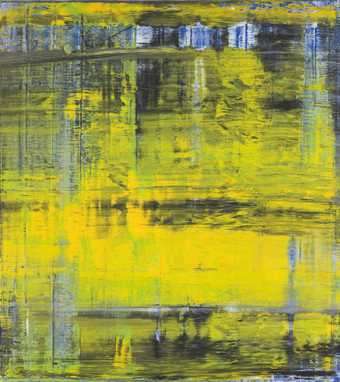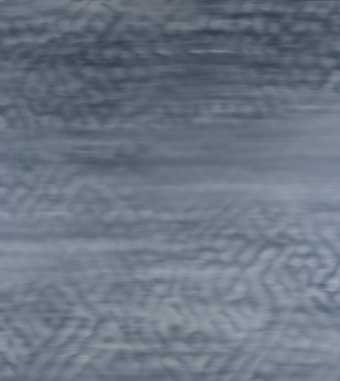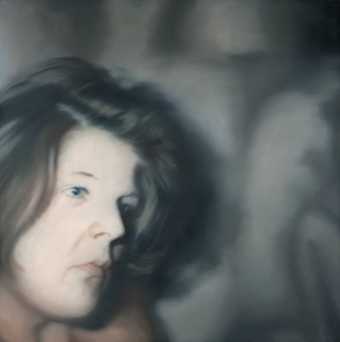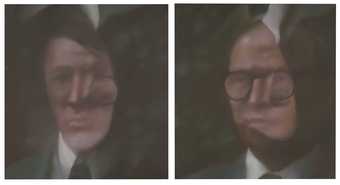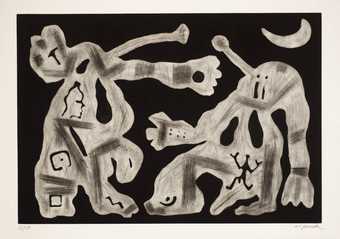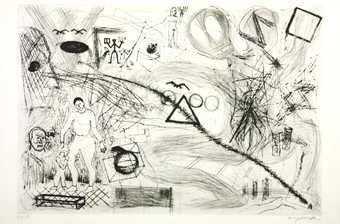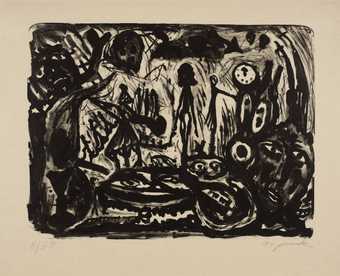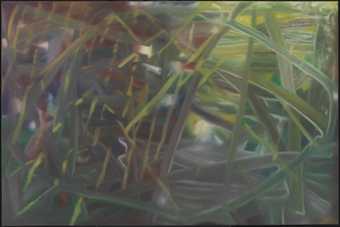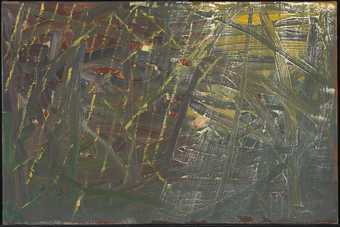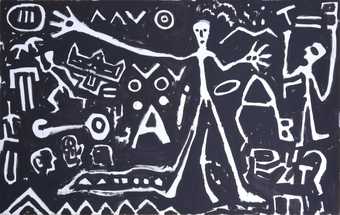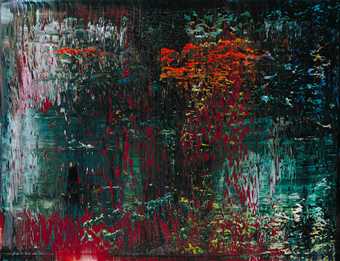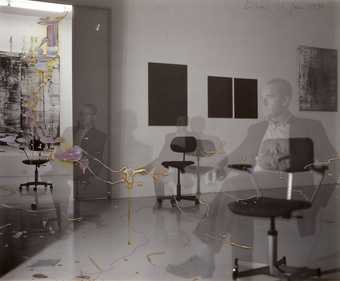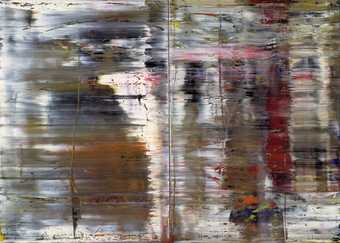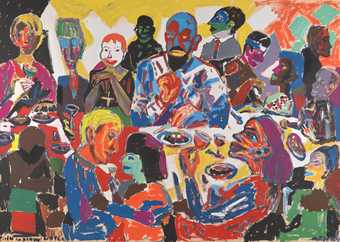
Not on display
- Artist
- A.R. Penck (Ralf Winkler) 1939 – 2017
- Original title
- Westen
- Medium
- Acrylic paint on canvas
- Dimensions
- Support: 2502 × 4000 × 24 mm
- Collection
- Tate
- Acquisition
- Purchased 1981
- Reference
- T03303
Display caption
Penck visited Baselitz on the day before the border between East and West Berlin was closed in 1961, but was obliged to remain in the East for another two decades. His subversion of the cultural and political ideology of East Germany was necessarily discrete. After emigrating in 1980, he could be more explicit and West with its companion East were made soon afterwards. Pared down to a simple language of signs – stick figures with symbols such as the cross and the hammer and sickle - Penck’s style embodied a radical way of reimagining German history.
Gallery label, November 2008
Does this text contain inaccurate information or language that you feel we should improve or change? We would like to hear from you.
Catalogue entry
T03303 WEST 1980
Not inscribed
Acrylic on canvas, 98 1/2 × 157 1/2 (250 × 400)
Purchased from the Galerie Michael Werner (Grant-in-Aid) 1981
'West’ [T03303] and ‘East’ [T03304] were painted in September 1980 and were the first large works Penck made after his emigration from East Germany in August 1980. They were shown at the Galerie Michael Werner, Cologne the following November.
'East’ (Osten), which was painted first, is the more reflective and autobiographical of the two, representing Penck's vision of East German society and his final, intolerable place within it. ‘West’ (Westen) can be read as a more immediate response to the experience of emigrating and to the artist's arrival in West Germany. The picture was originally to have been called Übergang (literally, ‘Crossing over’), a recurrent theme of Penck's work.
Both pictures are painted in black acrylic on a white ground, although to utterly dissimilar effect. In ‘East’, black paint covers most of the canvas, stopping only to allow figures and symbols to emerge in white, whereas the technique in ‘West’ is comparable to drawing or writing in black ink on white paper. Thus the forms in ‘West’ are more calligraphic, their outlines stronger and more regularly defined. In both pictures there are occasional areas of ambiguity where the black-white, positive-negative pattern is reversed or qualified. The principal contrast, however, is between positive space and negative figures (‘East’) and positive figures and negative or passive space (‘West’). This distinction reflects the way Penck sees the balance between individual action and social control in the two Germanies.
Although it is not possible to reduce every sign or symbol to a single meaning - Penck stresses that his pictures ‘are not newspapers’ - the artist has given a number of important clues. He describes his pictures as a mixture of ‘the abstract and concrete’. By abstract he means both universal experience (the contemporary political situation, for example), as well as geometric forms and a generally more schematic approach. ‘Concrete’ denotes subjective emotions and more realistic imagery.
With the exception of the fleeing man in the top left-hand corner, ‘East’ is a more static picture than ‘West’. The large central figure with outstretched right arm represents the artist straining to reach, but not quite touching, an oval object resembling a weapon (perhaps a hand grenade) or some more emblematic goal such as a paradisiacal enclave promising freedom. The running man is surrounded by symbols of power and repression: eagle, government or police building, hook, clamp. Between the hook and the central figure's elongated right foot are three heads belonging to friends from the ‘underground’. Lower still, beneath the large foot, is a jagged and dangerous terrain where no ideas circulate.
The concentric circles to the left of the main figure's head represent the ‘inner circle’ of authority, the highest position in East Germany's political hierarchy. To the right of his head an erupting volcano signifies ‘terror at the top’. The large letter ‘A’ beneath the figure's left hand stands for the East German system, while the smaller ‘B’ attached to it refers to the semi-official ‘alternative’ system based on transactions between East and West Germany. Penck emphasises that there are only ever two possibilities or choices in the East, the official and the unofficial, and this restriction is reflected in the frequent duplication or pairing of signs in the picture: for example, the clamp to the left of the fleeing man holds together two identical bars. The latter ‘signal’ (the artist's own term) recalls, like others in the painting, the geometrical-abstract forms of Penck's Standart (standard) series. These small pictures date from the late sixties and were the artist's first symbolic gesture against the regime.
'West’, by contrast, mirrors a more complex and ambivalent state of affairs. A number of figures of more or less equal weight are subjected to a degree of pressure from activity at the left and right sides of the picture, to the point of appearing to break up in the centre. The far right-hand figure with open ‘unsatisfied’ mouth represents the East as seen from the West. It is hooked by the mouth to a second figure brandishing in its other hand a weapon to which is attached a hammer and sickle. A third, smaller figure with a spear joins in the pursuit of a running man - the artist driven out of the East. At the extreme left of the painting, a tall double-headed figure holds a cross in one hand and a dollar sign in the other, representing the institutions of Church and Capital. The eagle-headed figure to its right is a symbol of government. Abstract signs are grouped more often in threes than twos, suggesting the multiplicity of choice which Penck recognises in the more ‘open’ society of the west.
The artist sums up the main difference between the two paintings as follows. ‘East’ shows a non-functioning machine in which the will to change one's personal circumstances is forever thwarted. ‘West’, with its much greater internal movement, is a machine which functions. Penck thought it would be interesting for Westerners to have, on the one hand, a clear picture of the Eastern system with all its parts; and on the other, a picture of the West through the eyes of one recently arrived from East Germany. He believes that we in the West tend to concentrate on and develop only a part of our system, our history, whereas he, Penck, tries to see the whole structure and its interrelationships.
The above entry is based on a conversation with the artist (7 December 1983).
Published in:
The Tate Gallery 1980-82: Illustrated Catalogue of Acquisitions, London 1984
Explore
- abstraction(8,615)
-
- from recognisable sources(3,634)
-
- figure(2,270)
- social comment(6,584)
-
- contemporary society(640)
- displacement(24)
- migration(20)
- western society(31)
You might like
-
Gerhard Richter Abstract Painting (809-3)
1994 -
Gerhard Richter Abstract Painting (Skin) (887-3)
2004 -
Gerhard Richter Brigid Polk (305)
1971 -
Gerhard Richter Gilbert, George (381-1, 381-2)
1975 -
Gerhard Richter Grey
1974 -
A.R. Penck (Ralf Winkler) Communication
1984 -
A.R. Penck (Ralf Winkler) Thoughts in a Kibbutz
1984 -
A.R. Penck (Ralf Winkler) Munich after the Rain
1986–7 -
Gerhard Richter Abstract Painting No. 439
1978 -
Gerhard Richter Oil Sketch No. 432/11
1977 -
A.R. Penck (Ralf Winkler) East
1980 -
Gerhard Richter St John
1988 -
Gerhard Richter Self-Portrait, Three Times, 24.1.90
1990 -
Gerhard Richter Abstract Painting (726)
1990 -
A.R. Penck (Ralf Winkler) Dinner at Brown’s Hotel
1984

